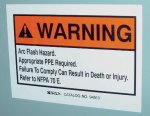I could use some clarification on PPE in an Industrial setting. It is my understanding that the proper PPE must be worn by people when interacting with equipment labeled other than HRC0. Or say, If I was to turn on or off a disconnect switch, I must wear gloves, fr clothes, glasses and hearing protection even with the disconnect door closed. When it has been verified that power is isolated, I can take off my PPE.
In my opinion it is way overkill to have to wear all that PPE when mearly approaching a closed panel, although I agree a lesser flash potential may remain. If the above is true, why is it OK for untrained personnel to do so without PPE (say, a Janitor trowing a disconnect)?
Anyone walking by within the 3.5 ft boundary would be in violation? Does not make sense to me.
In my opinion it is way overkill to have to wear all that PPE when mearly approaching a closed panel, although I agree a lesser flash potential may remain. If the above is true, why is it OK for untrained personnel to do so without PPE (say, a Janitor trowing a disconnect)?
Anyone walking by within the 3.5 ft boundary would be in violation? Does not make sense to me.


